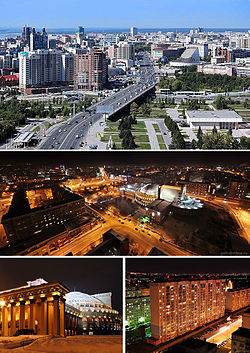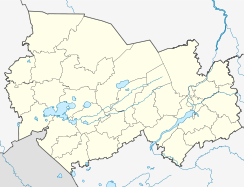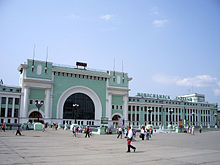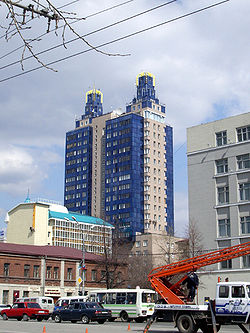- Novosibirsk
-
Novosibirsk (English)
Новосибирск (Russian)- City[1] -
City of oblast significance[2]

Location of Novosibirsk Oblast in RussiaCoordinates: 55°01′N 82°56′E / 55.017°N 82.933°ECoordinates: 55°01′N 82°56′E / 55.017°N 82.933°E Coat of arms of Novosibirsk Flag of Novosibirsk City Day Last Sunday of June[3] Administrative status (as of 2008) Country Russia Federal subject Novosibirsk Oblast[1] Administrative center of Novosibirsk Oblast, Novosibirsky District[4][5] Municipal status (as of August 2009) Urban okrug Novosibirsk Urban Okrug[1] Administrative center of Novosibirsky Municipal District[6] Mayor[8] Vladimir Gorodetsky[7] Representative body Council of Deputies[9] Statistics Area (city) (2007) 503.1 km2 (194.2 sq mi)[10] Population (2010 Census,
preliminary)1,473,737 inhabitants[11] - Rank in 2010 3rd Population (2002 Census) 1,425,508 inhabitants[12] - Rank in 2002 3rd Density 2,929 /km2 (7,590 /sq mi)[13] Time zone OMSST (UTC+07:00)[14] Founded 1893[15] City status since 10 January, 1904 [O.S. 28 December 1903][16] Previous names Novonikolayevsk (until February 12, 1926)[16] Postal code(s) 630000–630992, 901073, 901077[17] Dialing code(s) +7 383[10] Official website Novosibirsk (Russian: Новосибирск, IPA: [nəvəsʲɪˈbʲirsk]) is the third-largest city in Russia, after Moscow and Saint Petersburg, and the largest city of Siberia, with a population of 1,473,737 (2010 Census preliminary results).[11] It is the administrative center of Novosibirsk Oblast as well as of the Siberian Federal District. The city is located in the southwestern portion of the federal district and occupies an area of 477.2 square kilometers (184.2 sq mi).[18]
Contents
History
It was founded in 1893 at the future site of a Trans-Siberian Railway bridge crossing the great Siberian river of Ob and was named Novonikolayevsk (Новониколаевск), in honor of both Saint Nicholas and the reigning Tsar Nicholas II. The bridge was completed in the spring of 1897, making the new settlement the regional transport hub. The importance of the city further increased with the completion of the Turkestan-Siberia Railway in the early 20th century. The new railway connected Novosibirsk to Central Asia and the Caspian Sea.[19]
At the time of the bridge's opening, Novonikolayevsk hosted a population of 7,800 people. Its first bank opened in 1906, with a total of five banks operating by 1915. In 1907, Novosibirsk, now with a population exceeding 47,000, was granted town status with full rights for self-government. The pre-revolutionary period saw the population of Novosibirsk reach 80,000. During this period the city experienced steady and rapid economic growth, becoming one of the largest commercial and industrial centers of Siberia and developing a significant agricultural processing industry, as well as a power station, iron foundry, commodity market, several banks, and commercial and shipping companies. By 1917, Novosibirsk possessed seven Orthodox churches and one Roman Catholic church, several cinemas, forty primary schools, a high school, a teaching seminary, and the Romanov House non-classical secondary school. In 1913, Novonikolayevsk became one of the first places in Russia to institute compulsory primary education.[19]
The Russian Civil War took a toll on the city, with wartime epidemics, especially typhus and cholera, claiming thousands of lives. In the course of the War the Ob River Bridge was destroyed and for the first time in its history the population of Novonikolayevsk began to decline. The Soviet Workers' and Soldiers' Deputies of Novonikolayevsk took control of the city in December 1917. In May 1918, Czechoslovak prisoners of war rose in opposition to the revolutionary government and, together with the White Guards, captured Novonikolayevsk. The Red Army took the city in 1919, retaining it throughout the rest of the Civil War.[19]
Novonikolayevsk began reconstruction in 1921 at the start of Lenin's New Economic Policy. It was given its new name, Novosibirsk, in 1926.[19] The new name can be translated as "New Siberian City".
During Stalin's industrialization push, Novosibirsk secured its place as one of the largest industrial centers of Siberia. Several massive industrial facilities were created in the city, including the 'Sibkombain' plant, specializing in the production of heavy mining equipment. Additionally a metal processing plant, a food processing plant and other industrial enterprises and factories were built, as well as a new power station. The Great Soviet Famine saw the influx of more than 170,000 refugees to Novosibirsk. The new arrivals settled in barracks at the outskirts of the city, giving rise to slums such as Bolshaya Nakhalovka, Malaya Nakhalovka, and others.[19]
Rapid growth and industrialization were the reasons behind Novosibirsk's nickname: the "Chicago of Siberia".[20]
Tram rails were laid in 1934, by which time the population had reached 287,000, making Novosibirsk the largest city in Siberia. The following year the original bridge over the Ob River was replaced by the new Kommunalny bridge.[19]
The rapid growth of the city prompted the construction of a hydroelectric power station with a capacity of 400,000[21] kilowatts, necessitating the creation of a giant water reservoir, now known as the Ob Sea. As a direct result of the station's construction vast areas of fertile land were flooded as were relic pine woods in the area; additionally, the new open space created by the reservoir's surface caused average wind speeds to double, increasing the rate of soil erosion.[19]
In the 1950s, the Soviet Government directed that a center for scientific research be built in Novosibirsk; consequently, the multi-facility scientific research complex of Akademgorodok was constructed about 30 kilometers (19 mi) south of the city center in 1957. The Siberian Branch of the Academy of Sciences has its headquarters in Akademgorodok, and the town hosts a total of fourteen research institutions and universities. Although it possesses a fully autonomous infrastructure, Akademgorodok is administratively a part of Novosibirsk.
On September 2, 1962, the population of Novosibirsk reached one million. At that time, it was the youngest city in the world with over a million people. Novosibirsk took fewer than seventy years to achieve this milestone.[22]
In 1979, work began on the Novosibirsk Metro Transit System, culminating in the opening of the first line in 1985.[19]
On August 1, 2008, Novosibirsk was in the center of the path of a solar eclipse, with a duration of 2 minutes and 20 seconds.
Geography and climate
Location
The city stands on the banks of the Ob River in the West Siberian Plain. To the south of the city lies the Ukok Plateau, which forms part of the Golden Mountains of Altai UNESCO World Heritage Site.[23]
Climate
The climate is humid continental (Koppen Dfb), with warm summers and severely cold winters. Snow is frequent, falling on almost half of winter days, but individual snowfalls are usually light. Average temperatures range in summer is from +15 °C (59 °F) to +26 °C (79 °F), in winter from −20 °C (−4 °F) to −12 °C (10 °F). However, winter temperatures can go as low as −30 °C (−22 °F) to −35 °C (−31 °F), and summer temperatures can go as high as +30 °C (86 °F) to +35 °C (95 °F).[18] The difference between the record high and the record low temperatures is 88 °C (158 °F). Most days the weather is sunny, with an average of 2,880 hours of sunshine per year, but heavy rain is possible in summer.[18]
Travelers coming from countries with mild climates may find Novosibirsk’s winter tough, but it will not be extraordinary for those from northern countries. At times, bitter cold may hold for some days, but temperatures of −40 °C (−40 °F) and lower do not occur every year. In the springtime, streets and roads become dirty as a result of mud and melting snow, while the weather is still cold.
Climate data for Novosibirsk Month Jan Feb Mar Apr May Jun Jul Aug Sep Oct Nov Dec Year Average high °C (°F) −12.2
(10.0)−10.3
(13.5)−2.6
(27.3)8.1
(46.6)17.5
(63.5)24.0
(75.2)25.7
(78.3)22.2
(72.0)16.6
(61.9)6.8
(44.2)−2.9
(26.8)−8.9
(16.0)7.0 Daily mean °C (°F) −16.2
(2.8)−14.7
(5.5)−7.2
(19.0)3.2
(37.8)11.6
(52.9)18.2
(64.8)20.2
(68.4)17.0
(62.6)11.5
(52.7)3.4
(38.1)−6
(21.2)−12.7
(9.1)2.4 Average low °C (°F) −20.1
(−4.2)−19.1
(−2.4)−11.8
(10.8)−1.7
(28.9)5.6
(42.1)12.3
(54.1)14.7
(58.5)11.7
(53.1)6.4
(43.5)0.0
(32.0)−9.1
(15.6)−16.4
(2.5)−2.3 Precipitation mm (inches) 19
(0.75)14
(0.55)15
(0.59)24
(0.94)36
(1.42)58
(2.28)72
(2.83)66
(2.6)44
(1.73)38
(1.5)32
(1.26)24
(0.94)442
(17.4)Source: "Mean monthly climatic data for the city of Novosibirsk from 1961 to 1990". Roshydromet. http://meteoinfo.ru/climate/klimatgorod/1716-1246618396. Retrieved 2010-10-17. Flora
The most prominent tree genera native to Novosibirsk are birch, pine, and aspen. Some mountain ash, hawthorn, spruce, and fir are also present. European species of apple, ash, elm, linden, and oak have been successfully introduced.
Fauna
Large mammals native to the Novosibirsk area include the brown bear, reindeer, moose (elk), wolf, and fox. Also present are wolverine, ermine, marten, weasel, and polecat. The predators among them are supported by populations of beaver, hare, mouse, hamster, vole, shrew, squirrel, and chipmunk. More than 350 species of birds have been recorded. On the other hand, only a few cold-blooded vertebrate species occur on land, but they include the venomous adder and the swift grass snake. Perch and carp are prominent among the fish, of which there are more than thirty species. The carp often host a dangerous parasite, the liver fluke. Ticks in the area are frequent carriers of viral encephalitis.
Broadcasting
Novosibirsk is home to Russia's most powerful shortwave relay station east of the Ural mountains. This relay station can reach most of South Asia, the Middle East, and the China. The Magadan and Vladivostok relay stations when operated in conjunction with Novosibirsk can guarantee that the Voice of Russia or any other broadcaster renting time at Novosibirsk is heard in the intended target area.
Transport
Novosibirsk is the third-largest city in Russia (after Moscow and St. Petersburg) and the first in Siberia in which a metro system was established (the Novosibirsk Metro, opened in 1985). The city is served by Novosibirsk Tolmachevo Airport with regular flights to Europe and Asia as well as to other Russian cities. Tolmachevo is the hub for S7 Airlines. There is also the auxiliary Novosibirsk Elitsovka Airport and a smaller field for general aviation at Novosibirsk Severny Airport. Novosibirsk was one of the stops for the 2008 edition of the popular television show, "The Amazing Race (Series 14, Leg 5)."
Economy
 The administrative building of Novosibirsk Oblast
The administrative building of Novosibirsk Oblast
Novosibirsk is a large industrial center. The industrial complex consists of 214 large and average industrial enterprises. These produce more than two thirds of all industrial output of the Novosibirsk region. Leading industries are the electric power industry, gas supply, water supply, metallurgy, metal working, and mechanical engineering.
According to the television station RBC Novosibirsk took third place in 2008 in the list of the cities of Russia most attractive to business (in 2007 it was placed thirteenth).
Before the relocation of its headquarters to Ob, S7 Airlines had its head office in Novosibirsk.[24]
The headquarters' of a number of large Russian companies are located in Novosibirsk:[25]
- RATM Holding
- Belon
- The Siberian coast» Food Company (until 2009)
- NETA IT Company (Retail, System Integrator, Software Sales)
- Parallels IT Company (Software for virtualization)
- Inmarko Food Company
- Siberian Food Corporation
- Electro-vacuum plant (the largest glass bottles factory in Asian part of country)
A number of modern business complexes operate in Novosibirsk:
- Grinvich, Class A
- RusEuroPlaza, Class A
- Kronos, Class A
- Golden Plaza, Class A
- Cobra, Class A
- Novograd, Class B
- Technocom, Class B
Sports
Several professional sports clubs are active in the city:
- HC Sibir Novosibirsk - ice hockey, Kontinental Hockey League
- FC Sibir Novosibirsk - football, Russian Premier League (from 2010-2011)
- Lokomotiv Novosibirsk - Men's volleyball team
- Sibirtelecom Lokomotiv Novosibirsk - Men's basketball team, Russian Basketball Super League
- Dynamo-GUVD Novosibirsk - Women's basketball, Russian Women's Basketball Super League, former national Champions
- HC Sibselmash[26] — bandy, Russian Bandy League, former national Champions [27]
Novosibirsk is the home town of several former Olympians, including Alexander Karelin, a twelve-time world Greco-Roman wrestling champion who has been voted the greatest Greco-Roman wrestler of the twentieth century by FILA.
Music
Several contemporary classical violinists – Vadim Repin, the late Alexander Skwortsow, Natalia Lomeiko, and Maxim Vengerov – are natives of Novosibirsk. Also born in the city were punk legend, poet and singer-songwriter Yanka Dyagileva and folk/folk–rock singer Pelageya Khanova and cellist Tatjana Vassiljeva.
The city possesses a Conservatory (named in honor of Mikhail Glinka), Novosibirsk Academic Symphony Orchestra, and several notable music venues.
Education
Novosibirsk is home to the following educational institutions:
- Novosibirsk State Conservatoire (1956)
- Novosibirsk State Agricultural University
- Novosibirsk State Architecture and Construction University (1930)
- Novosibirsk State Medical University (1935)
- Novosibirsk State Pedagogical University (1935)
- Novosibirsk State University (1959)
- Novosibirsk State Technical University (1950)[28]
- Siberian State University of Telecommunications and Information Sciences (1953)
- Novosibirsk State Academy of Architecture and Arts (1989)
- Novosibirsk State Academy of Water Transportation Engineering (1951)
- Siberian University of Consumer Cooperatives (1956)
- Novosibirsk State University Of Economics And Management (1929)
- Siberian State Academy of Geodesy (1933)
- Siberian State Transport University (1932)
Akademgorodok is a suburb of Novosibirsk dedicated to science. It houses the Siberian division of the Russian Academy of Sciences and is the location of Novosibirsk State University. (All other higher education institutions are located in the central part of the city.)
The Novosibirsk Zoo
The Novosibirsk Zoo is a world-renowned scientific institution as well as a popular tourist attraction. The zoo has over four thousand animals and is an active participant of thirty-two different captive breeding programmes for endangered species. On average, around 700,000 people visit the zoo each year.
In 2000, the zoo held the closest relative to the cape lion of South Africa. John Spence was always fascinated about the stories of these grand lions scaling the walls of General van Riebeeck's castle in the 17th century. Spence's search took thirty years, which led him to the Novosibirsk Zoo, where he found the closest living resemblance to the cape lion; the zoo called the lion Simon. The lion and his family are kept outdoors in large, natural settings. "It is kept all the year around in the climate conditions of the west Siberia at the temperatures from −49 °C (−56 °F) to 36 °C (97 °F). In forty years, more than sixty cubs were born."[29]
The zoo's current curator is Rostislav Shilo. Simon's cubs were named after him and his wife, Olga.[30]
Twin towns/Sister cities
Novosibirsk is twinned with:
Gallery
-
Spartak Stadium (Novosibirsk).jpg
Spartak Stadium (Novosibirsk) and city surrondings
References
Notes
- ^ a b c Registry of the Inhabited Localities of Novosibirsk Oblast, Section I
- ^ Государственный комитет Российской Федерации по статистике. Комитет Российской Федерации по стандартизации, метрологии и сертификации. №ОК 019-95 1 января 1997 г «Общероссийский классификатор объектов административно-территориального деления. Код 50 401», в ред. изменения №168/2011 от 1 октября 2011 г. (State Statistics Committee of the Russian Federation. Committee of the Russian Federation on Standardization, Metrology, and Certification. #OK 019-95 January 1, 1997 Russian Classification of Objects of Administrative Division . Code 50 401, as amended by the Amendment #168/2010 of October 1, 2011. ).
- ^ Charter of Novosibirsk, Article 1.5
- ^ Charter of Novosibirsk Oblast, Article 5.2
- ^ Государственный комитет Российской Федерации по статистике. Комитет Российской Федерации по стандартизации, метрологии и сертификации. №ОК 019-95 1 января 1997 г «Общероссийский классификатор объектов административно-территориального деления. Код 50 240», в ред. изменения №168/2011 от 1 октября 2011 г. (State Statistics Committee of the Russian Federation. Committee of the Russian Federation on Standardization, Metrology, and Certification. #OK 019-95 January 1, 1997 Russian Classification of Objects of Administrative Division . Code 50 240, as amended by the Amendment #168/2010 of October 1, 2011. ).
- ^ Law #246-OZ, Article 1.19
- ^ Official website of Novosibirsk. Biography of Vladimir Philippovich Gorodetsky (Russian)
- ^ Charter of Novosibirsk, Article 27.1.2
- ^ Charter of Novosibirsk, Article 27.1.1
- ^ a b Official website of Novosibirsk. Business Card of the City of Novosibirsk (Russian)
- ^ a b Федеральная служба государственной статистики (Federal State Statistics Service) (2011). "Предварительные итоги Всероссийской переписи населения 2010 года (Preliminary results of the 2010 All-Russian Population Census)" (in Russian). Всероссийская перепись населения 2010 года (All-Russia Population Census of 2010). Federal State Statistics Service. http://www.perepis-2010.ru/results_of_the_census/results-inform.php. Retrieved 2011-04-25.
- ^ Федеральная служба государственной статистики (Federal State Statistics Service) (2004-05-21). "Численность населения России, субъектов Российской Федерации в составе федеральных округов, районов, городских поселений, сельских населённых пунктов – районных центров и сельских населённых пунктов с населением 3 тысячи и более человек (Population of Russia, its federal districts, federal subjects, districts, urban localities, rural localities—administrative centers, and rural localities with population of over 3,000)" (in Russian). Всероссийская перепись населения 2002 года (All-Russia Population Census of 2002). Federal State Statistics Service. http://www.perepis2002.ru/ct/doc/1_TOM_01_04.xls. Retrieved 2010-03-23.
- ^ The value of density was calculated automatically by dividing the 2010 Census population by the area specified in the infobox. Please note that this value may not be accurate as the area specified in the infobox does not necessarily correspond to the area of the entity proper or is reported for the same year as the population.
- ^ Правительство Российской Федерации. Постановление №725 от 31 августа 2011 г. «О составе территорий, образующих каждую часовую зону, и порядке исчисления времени в часовых зонах, а также о признании утратившими силу отдельных Постановлений Правительства Российской Федерации». Вступил в силу по истечении 7 дней после дня официального опубликования. Опубликован: "Российская Газета", №197, 6 сентября 2011 г. (Government of the Russian Federation. Resolution #725 of August 31, 2011 On the Composition of the Territories Included into Each Time Zone and on the Procedures of Timekeeping in the Time Zones, as Well as on Abrogation of Several Resolutions of the Government of the Russian Federation. Effective as of after 7 days following the day of the official publication).
- ^ Official website of Novosibirsk. History (Russian)
- ^ a b Charter of Novosibirsk, Article 1.1
- ^ Russian Post. Postal Code Search (Russian)
- ^ a b c "Novosibirsk City Guide — General information". © 2009 AllSiberia.Com. http://www.allsiberia.com/novosibirsk/Geninfo.htm. Retrieved July 9, 2009.
- ^ a b c d e f g h AllSiberia
- ^ "From Novosibirsk to Komsomolsk". TIME. Monday, May 4, 1942. http://www.time.com/time/magazine/article/0,9171,777759,00.html. Retrieved May 6, 2009.
- ^ "Novosibirsk, Siberia, Russia History & Info". Utopiasprings.com. http://www.utopiasprings.com/instnovo.htm. Retrieved May 6, 2009.
- ^ "Novosibirsk Mayor Office Web Site, City History Page". Novosibirsk Mayor Office. http://www.novo-sibirsk.ru/index/section/53. Retrieved February 13, 2008.
- ^ "Altai: Saving the Pearl of Siberia". http://www.pacificenvironment.org/article.php?list=type&type=83. Retrieved January 28, 2010.
- ^ "World Airline Directory." Flight International. March 30 - April 5, 2004. 68.
- ^ "Siberian business portal KSONLINE [1].
- ^ "Официальный сайт ХК Сибсельмаш (Новосибирск)". Sibselmash.nsk.ru. http://www.sibselmash.nsk.ru/. Retrieved 2011-09-16.
- ^ Sibselmash training: http://www.youtube.com/watch?v=KIAUWFjaM2I&feature=related
- ^ "Государственные вузы Новосибирской области". Sr-nso.nstu.ru. http://sr-nso.nstu.ru/vus/gos_vus/. Retrieved 2011-09-16.
- ^ "Лев". Sibzoo.narod.ru. http://sibzoo.narod.ru/animal/lev.htm. Retrieved January 28, 2010.[dead link]
- ^ "Has Rare Lion of Africa's Cape Eluded Extinction?". National Geographic News. http://news.nationalgeographic.com/news/2001/07/0726_capelion_2.html. Retrieved January 28, 2010.
- ^ (Japanese) 札幌市 - 国際交流 - 姉妹都市
- ^ (Japanese) Sister Cities | International Community Bureau
- ^ Novosibirsk official site
Sources
- Городской Совет Новосибирска. Решение №616 от 27 июня 2007 г. «Устав города Новосибирска», в ред. Решения №1341 от 23 сентября 2009 г. «О внесении изменений в устав города Новосибирска, принятый Решением городского Совета Новосибирска от 27.06.2007 №616». Вступил в силу через 10 дней со дня официального опубликования, за исключением положений, для которых установлены иные сроки и порядок вступления в силу. Опубликован: "Бюллетень органов городского самоуправления Новосибирска", №58, стр. 3, 15 августа 2007 г. (City Council of Novosibirsk. Decision #616 of June 27, 2007 Charter of the City of Novosibirsk, as amended by the Decision #1341 of September 23, 2009 On Amending the Charter of the City of Novosibirsk Adopted by the Decision #616 of the City Council of Novosibirsk of June 27, 2007. Effective as of 10 days after the official publication date, with the exception of the clauses for which different dates and procedures of taking effect are specified).
- Администрация Новосибирской области. 2007 «Реестр населённых пунктов Новосибирской области». Опубликован: "Советская Сибирь", №146, 31 июля 2007 г. (Administration of Novosibirsk Oblast. 2007 Registry of the Inhabited Localities of Novosibirsk Oblast. ).
- Новосибирский областной Совет депутатов. Постановление №282-ОЗ от 31 марта 2005 г. «Устав Новосибирской области (текст в ред. от 8 июля 2010 г.)», в ред. Закона №513-ОЗ от 15 июля 2010 г «О поправках к Уставу Новосибирской области». Вступил в силу 1 мая 2005 г. Опубликован: "Советская Сибирь", №81, 29 апреля 2005 г. (Novosibirsk Oblast Council of Deputies. Resolution #282-OZ of March 31, 2005 Charter of Novosibirsk Oblast (text of rev. of July 8, 2010), as amended by the Law #513-OZ of July 15, 2010 On Amending the Charter of Novosibirsk Oblast. Effective as of May 1, 2005).
- Новосибирский областной Совет депутатов. Закон №246-ОЗ от 17 декабря 2004 г. «Об административных центрах муниципальных районов и сельских поселений Новосибирской области», в ред. Закона №69-ОЗ от 5 декабря 2006 г. «О внесении изменений в Закон Новосибирской области "Об административных центрах муниципальных районов и сельских поселений Новосибирской области"». Вступил в силу со дня официального опубликования. Опубликован: "Советская Сибирь", №252, 29 декабря 2004 г.. (Novosibirsk Oblast Council of Deputies. Law #246-OZ of December 17, 2004 On the Administrative Centers of the Municipal Districts and Rural Settlements of Novosibirsk Oblast, as amended by the Law #69-OZ of December 5, 2006 On Amending the Law of Novosibirsk Oblast "On the Administrative Centers of the Municipal Districts and Rural Settlements of Novosibirsk Oblast". Effective as of the official publication date).
External links
- News from Novosibirsk - the main local TV station "Vesti-Novosibirsk" (Russian)
- Novosibirsk skyline photos
- Novosibirsk business news
- Novosibirsk MIRNSK.Ru
- Life of Novosibirsk in photos
- CNN article on Siberian IT industry
- Novosibirsk city views
- Novosibirsk: Global scientific center rises in the midst of Siberia's forests
Cities and towns in Novosibirsk Oblast Administrative center: Novosibirsk
 Categories:
Categories:- Cities and towns in Novosibirsk Oblast
- Novosibirsk
- Populated places established in 1893
Wikimedia Foundation. 2010.








